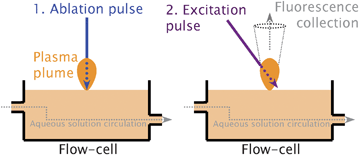Improving laser-induced breakdown spectroscopy (LIBS) performance for iron and lead determination in aqueous solutions with laser-induced fluorescence (LIF)
Abstract
The combination of

* Corresponding authors
a
INRS Énergie, Matériaux et Télécommunications, 1650 Boul. Lionel-Boulet, Varennes, Québec, Canada
E-mail:
vidal@emt.inrs.ca
Fax: +1 450 929 8102
Tel: +1 450 929 8118
b National Research Council of Canada, Industrial Materials Institute, 75 de Mortagne Blvd, Boucherville, Québec, Canada
The combination of

 Please wait while we load your content...
Something went wrong. Try again?
Please wait while we load your content...
Something went wrong. Try again?
H. Loudyi, K. Rifaï, S. Laville, F. Vidal, M. Chaker and M. Sabsabi, J. Anal. At. Spectrom., 2009, 24, 1421 DOI: 10.1039/B909485G
To request permission to reproduce material from this article, please go to the Copyright Clearance Center request page.
If you are an author contributing to an RSC publication, you do not need to request permission provided correct acknowledgement is given.
If you are the author of this article, you do not need to request permission to reproduce figures and diagrams provided correct acknowledgement is given. If you want to reproduce the whole article in a third-party publication (excluding your thesis/dissertation for which permission is not required) please go to the Copyright Clearance Center request page.
Read more about how to correctly acknowledge RSC content.
 Fetching data from CrossRef.
Fetching data from CrossRef.
This may take some time to load.
Loading related content
